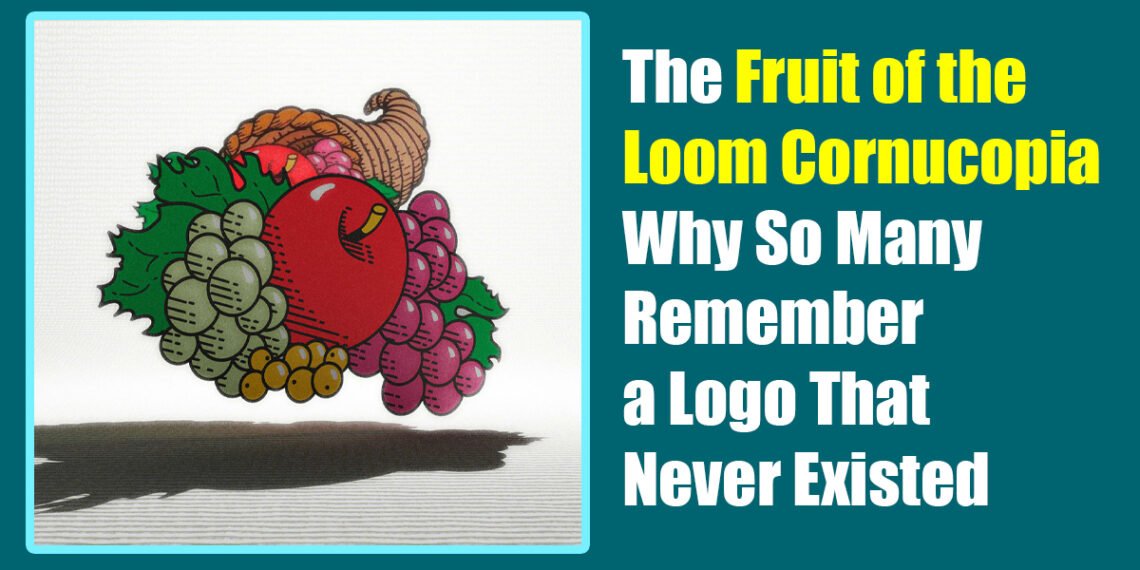Fruit of the Loom is one of the most recognizable American clothing brands, best known for its underwear, T-shirts, and casual apparel. But for decades, people have argued about one peculiar detail: did the logo once feature a cornucopia? Many insist they remember a horn of plenty spilling out fruit, while others only recall a cluster of fruit and leaves. The truth is stranger than memory the company has never used a cornucopia in its logo. Yet the memory persists, and this makes the Fruit of the Loom cornucopia one of the most famous cases of the Mandela Effect
The Brand’s Origins
Fruit of the Loom was founded in 1851 in Rhode Island by brothers Benjamin and Robert Knight. They chose the name after a friend painted fruit alongside cloth samples, symbolizing abundance, freshness, and quality. That imagery stuck, and the brand’s identity has been tied to fruit ever since. Over the years, the logo has featured apples, grapes, currants, and leaves, arranged in different artistic styles. What it has never included is a cornucopia.
Why the Cornucopia Memory Exists
The cornucopia, or horn of plenty, has long been a symbol of harvest and abundance. It is closely associated with Thanksgiving, where fruit and vegetables often appear inside a wicker horn. Psychologically, this makes it easy for the brain to associate fruit illustrations with a cornucopia. When people saw the Fruit of the Loom logo fruit clustered together many subconsciously filled in the missing piece: the container. Over time, this association solidified into a memory that feels real.
The Mandela Effect
This misremembering falls into what’s known as the Mandela Effect. Coined after large groups falsely remembered Nelson Mandela dying in prison in the 1980s, the Mandela Effect describes collective false memories. The Fruit of the Loom cornucopia has become one of its most famous examples. Many people confidently recall the logo with a cornucopia, even describing the texture and shape of the wicker horn, though no evidence supports its existence.
Psychological Roots of the Memory
Human memory is not a perfect record; it is reconstructive. That means the mind rebuilds memories each time they are recalled, often blending fact with expectation. Schema theory in psychology explains this well: people develop mental frameworks for common objects and ideas. A pile of fruit often belongs in a bowl or basket, or a cornucopia. So when the Fruit of the Loom logo showed fruit, the brain automatically “corrected” it by adding the expected container. Later, when recalling the image, people truly believed they had seen the cornucopia all along.
Reinforcement Through Culture
Beyond psychology, culture reinforced the false memory. School art projects often featured cornucopias, especially around Thanksgiving. Illustrations in books and decorations around holidays constantly paired fruit with a horn of plenty. It became natural to picture fruit in that context. Later, on the internet, discussions on Reddit, TikTok, and forums only reinforced this memory. When people saw others agree that they remembered a cornucopia, the belief felt validated, regardless of facts.
Trademark Confusion
Some also point to trademark filings, which list categories like “cornucopia; baskets of fruit.” This description caused further confusion, but it was only a filing code used for search and classification. The actual trademark images never contained a cornucopia. Legal language, however, may have led people to assume the company once used the symbol.
Pop Culture and Counterfeit Items
Another source of confusion may be counterfeit merchandise and pop culture references. Some knock-off shirts and products depicted the fruit spilling from a horn of plenty, further spreading the belief. A 1990s board game card even mentioned the logo with a cornucopia. While unofficial, these reinforcements blurred the line between authentic memory and outside influence.
Why the Myth Persists
False memories persist because they feel emotionally true. People are confident in their recollections, even in the face of contrary evidence. The cornucopia memory ties into nostalgia for childhood, clothing purchases, or family life. It also connects to holiday traditions. Together, these elements make the false image “stickier” than the real one.
Lessons About Memory
The Fruit of the Loom cornucopia teaches us valuable lessons about memory and culture. First, memory is not a perfect photograph; it is flexible, shifting, and vulnerable to suggestion. Second, collective misremembering is powerful when groups reinforce each other, belief hardens. Finally, symbols like the cornucopia are culturally so strong that they override fact. Even when shown proof, many people will still insist they saw the cornucopia.
Conclusion
The Fruit of the Loom logo has never had a cornucopia, but countless people remember it vividly. This paradox illustrates the strange workings of human memory and the power of cultural imagery. The cornucopia memory lives on not because of corporate design choices, but because of the human brain’s tendency to fill gaps and reinforce belief through community and culture. It’s not just about a clothing logo it’s about how we remember, and how we sometimes misremember, together.
FAQs
Did Fruit of the Loom ever use a cornucopia in its logo?
No, the company has never included a cornucopia in its official logo. The design has always featured a cluster of fruit and leaves.
Why do so many people remember the cornucopia?
The memory is shaped by psychology and culture. People often link fruit with a horn of plenty, and over time, that association felt like reality.
Is the Fruit of the Loom cornucopia part of the Mandela Effect?
Yes, it is one of the most popular examples. The Mandela Effect describes when large groups share the same false memory.
Could counterfeit products have caused confusion?
Yes, unofficial merchandise and cultural references may have reinforced the idea that the logo once included a cornucopia.
What can we learn from this false memory?
It shows that human memory is not flawless. Our minds reconstruct images, and cultural reinforcements can make us believe something that never existed.



